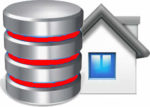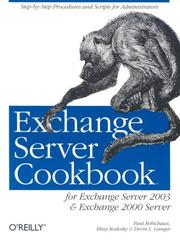Step-by-Step Procedures and Scripts for Windows Network
O’Reilly Releases “Exchange Server Cookbook”
Exchange Server Cookbook by Paul Robichaux, Missy Koslosky, and Devin L. Ganger
Step-by-Step Procedures and Scripts for Windows Network Administrators O’Reilly Releases “Exchange Server Cookbook”
For Exchange Server 2003 and Exchange 2000 Server.
Ask anyone at any company with more than fifty employees what their most critical computer application is, and most will say “email” without hesitation. Among the messaging systems critical to businesses today, Microsoft’s popular Exchange software has come a long way since its introduction in 1996. Yet, according to the company, sixty percent of the seats or workstations that use the software still depend on Exchange 5.5, the version released in 1997, despite the availability of Exchange 2000 and, more recently, Exchange Server 2003.
“The release of Windows Server 2003 addresses the majority of the underlying issues with Active Directory that kept many companies from upgrading sooner,” comments author Paul Robichaux, a longtime Exchange consultant and author of columns and books on the subject, including “Exchange Server Cookbook” (O’Reilly, US $44.95). “Exchange Server 2003 is making huge inroads in the Exchange 5.5 installed base, and much of what’s in this book is stuff that experienced 5.5 administrators need to know.”
Coauthored by Devin Ganger and Missy Koslosky, this cookbook offers Windows network administrators a comprehensive how-to guide to the most common tasks for both Exchange 2000 Server and Exchange Server 2003–everything from installation and maintenance to configuration and optimization–along with details on the most useful tools and utilities, and solutions to uncommon tasks and advanced procedures. As with other O’Reilly cookbooks, the recipes in “Exchange Server Cookbook” are immediate and practical solutions to specific problems and tasks, organized by subject so that administrators can quickly find what they need.
“Exchange is a rich messaging system, but there are lots of hidden tricks and features that not everyone knows,” Robichaux explains. Microsoft has gone to great lengths to hide much of Exchange’s complexity by providing a set of GUI tools and wizards, he says, but for those who want to make better use of features and capabilities that lie beneath the GUI veneer, the cookbook’s recipes also provide command line options and working script examples for automating management and deployment tasks.
“Our book is designed to give readers more than one way to complete a task,” Koslosky explains. “Scripting for Exchange isn’t widespread, and most books on Exchange don’t cover scripting at all. We hope the book will help administrators get used to it, so, as they become more comfortable, they will enhance the scripts we provide in the book.”
Topics covered in the “Exchange Server Cookbook” include:
-The relationship between Exchange and Active Directory -When to use the GUI, the command line, or scripting
-How to prepare forests, domains, and servers -How to use Group Policy to control Exchange
-Diagnostic logging, measure performance, and administrative privileges
-Recipient management: user accounts, mailboxes, mail-enabled groups
-Mailbox and public folder database management -Message routing and transport functions
-Security, backup, restore, and recovery operations
“The cookbook format provides a unique opportunity for learning new ways to do familiar tasks,” Ganger remarks. “Most Exchange administrators don’t have the luxury of time to research new approaches and they can benefit from a thorough set of task-oriented recipes that show them how. This is the book I could have used when I first started learning Exchange.”
Table of Contents
Preface
1. Getting Started
Cooking with Exchange
Where to Get Tools
Finding More Information
2. Installation and Infrastructure
2.1 Verifying Your Current Infrastructure Is Ready for Exchange Server 2003
2.2 Preparing a Windows 2000 Server Computer for an Exchange Installation
2.3 Preparing a Windows Server 2003 Computer for an Exchange Installation
2.4 Preparing an Active Directory Forest for Exchange
2.5 Preparing an Active Directory Domain for Exchange
2.6 Verifying That Forest and Domain Preparation Completed
2.7 Installing Exchange on a Member Server
2.8 Installing Exchange on a Domain Controller
2.9 Using Exchange Setup in Unattended Mode
2.10 Checking the Expiry Date of an Evaluation Version of Exchange
2.11 Upgrading the Evaluation Version of Exchange
2.12 Upgrading from Standard Edition to Enterprise Edition
2.13 Enumerating All Existing Exchange Servers
2.14 Enumerating All Exchange Connectors
2.15 Switching Exchange from Mixed Mode to Native Mode
2.16 Creating the First Administrative Group with a Custom Name
2.17 Viewing Administrative Groups in Exchange System Manager
2.18 Creating Administrative Groups
2.19 Removing Administrative Groups
2.20 Moving Objects Between Administrative Groups
3. Active Directory Integration
3.1 Determining Which Domain Controllers Exchange Is Using
3.2 Forcing Exchange to Use Specific Domain Controllers
3.3 Determining and Specifying the DC That ESM Uses
3.4 Removing Exchange from Active Directory
3.5 Changing the Forest Functional Level
3.6 Controlling Exchange Settings Through Group Policy Objects
3.7 Installing Additional Recipient Update Service Instances
3.8 Troubleshooting DSAccess Topology Discovery
3.9 Checking Which Account or Group Has Been Assigned Permissions During ForestPrep
4. Exchange Server and Organization Management
4.1 Installing ESM on Windows XP
4.2 Starting and Stopping Exchange
4.3 Controlling Message Tracking Settings
4.4 Determining Whether a Server Is a Front-End Server
4.5 Applying Exchange System Policies
4.6 Monitoring Exchange Service Status
4.7 Controlling Diagnostic Logging
4.8 Measuring Exchange Performance
4.9 Delegating Administrative Control
4.10 Setting Default Send and Receive Size Limits
5. Recipient Management
5.1 Creating a User Account and Mailbox
5.2 Creating a Mailbox for an Existing User
5.3 Removing a Mailbox for an Existing User
5.4 Creating a Mail-Enabled Group
5.5 Controlling Mailbox Size Limits
5.6 Moving Mailboxes
5.7 Getting Mailbox Access and Logon Information
5.8 Determining the Size of a Mailbox
5.9 Recovering a Deleted Mailbox
5.10 Bulk-Adding Mailboxes from an Excel Worksheet
5.11 Creating a Mail-Enabled Contact
5.12 Creating Multiple Address Lists
5.13 Creating Query-Based Distribution Groups
5.14 Granting Full Access to Mailboxes
5.15 Getting the List of Delegates for a Mailbox
5.16 Changing the Display Name Format in the GAL
5.17 Hiding or Revealing Items in Address Lists
5.18 Setting a Default Reply-to Address for a Mailbox
5.19 Creating Recipient Policies
5.20 Limiting Who Can Send Mail to a Distribution Group
5.21 Granting Send-as Permissions
5.22 Granting Send on Behalf of Permissions
5.23 Granting Users or Groups Permission to Access Other Mailboxes
5.24 Limiting the Number of Recipients to Which Messages Can Be Sent
5.25 Creating and Using Offline Address Lists
5.26 Using Mailbox Manager
5.27 Using ADModify.NET to Update User Attributes
5.28 Setting Properties on User Accounts
5.29 Retrieving Properties on User Accounts
6. Mailbox and Public Folder Database Management
6.1 Creating a Storage Group
6.2 Deleting a Storage Group
6.3 Enumerating the Storage Groups on a Server
6.4 Creating a Mailbox Database
6.5 Creating a Public Folder Database
6.6 Deleting a Database
6.7 Mounting a Database
6.8 Dismounting a Database
6.9 Moving Databases and Logs to Different Disks
6.10 Determining How Much Whitespace Is in a Database
6.11 Finding the Low Anchor Log File
6.12 Rebuilding a Database File from Logs
6.13 Enumerating Connected Mailboxes in a Database
6.14 Turning on Circular Logging for a Storage Group
6.15 Controlling the Online Maintenance Process
6.16 Performing an Offline Defragmentation
6.17 Shrinking a Database That Exceeds the 16 GB Size Limit for Standard Edition
7. Transport, Routing, and SMTP
7.1 Creating a New SMTP Virtual Server
7.2 Choosing the Correct Connector
7.3 Creating a Routing Group Connector
7.4 Creating an SMTP Connector
7.5 Configuring a Connector to Allow Routing of Messages from Specific Senders
7.6 Allowing Large Messages Through Specific Connectors
7.7 Creating a Routing Group
7.8 Removing a Routing Group
7.9 Designating the Routing Group Master
7.10 Moving a Server Between Routing Groups
7.11 Examining Your Routing Structure
7.12 Listing the SMTP Queues on a Specific Virtual Server
7.13 Inspecting the Contents of a Queue
7.14 Deleting Messages from a Queue
7.15 Moving SMTP Queues to a New Location
7.16 Deleting Messages from the Badmail Folder
7.17 Sharing an SMTP Domain Between Exchange and a Foreign Mail System
7.18 Accepting Mail for Multiple Domains
7.19 Controlling Mail Relaying
7.20 Filtering Messages Based on Recipient
7.21 Setting IP Address Restrictions for Multiple Servers
7.22 Using a DNS Block List on Exchange Server 2003
7.23 Controlling Global and Internet Message Format Settings
7.24 Setting Up a Role Email Address
7.25 Verifying Your External DNS Configuration for Inbound SMTP
7.26 Testing SMTP Manually
8. Client Connectivity
8.1 Blocking Specific Versions of Outlook from Connecting
8.2 Configuring Attachment Blocking for Outlook
8.3 Fixing Mailbox Folder Names That Appear in the Wrong Language
8.4 Configuring Attachment Blocking for OWA 2003
8.5 Configuring Freedoc Access for OWA 2003
8.6 Controlling OWA 2003 Spellchecking
8.7 Enabling SSL for OWA
8.8 Configuring Form-Based Authentication for OWA 2003
8.9 Allowing Password Changes Through OWA
8.10 Changing OWA 2003 Session Timeouts
8.11 Using the OWA Web Administration Tool
8.12 Creating OWA 2003 Themes
8.13 Forcing Users to Use a Specific OWA Theme
8.14 Enabling the Use of FBA/SSL with Outlook Mobile Access and Exchange ActiveSync
8.15 Enabling Support for “Unsupported” Outlook Mobile Access Devices
8.16 Adding Mobile Carriers for Exchange ActiveSync
8.17 Disabling Exchange ActiveSync Certificate Checking
8.18 Installing a Root Certificate for Use with EAS
8.19 Configuring the POP3 Server for User Access
8.20 Configuring the IMAP4 Server for User Access
8.21 Configuring NNTP for Newsgroup Feeds
8.22 Disabling User Access to POP3, IMAP4, and HTTP
8.23 Using Protocol Logging
8.24 Making Exchange Work Behind a Cisco PIX Firewall
9. Public Folder Management
9.1 Using the Public Folder Migration Tool
9.2 Rehoming Public Folders
9.3 Getting and Setting Public Folder Permissions
9.4 Forcing Public Folder Replication
9.5 Replicating the Public Folder Hierarchy
9.6 Getting Properties of the Public Folder Tree
9.7 Creating and Deleting Public Folders
9.8 Mail-Enabling or Mail-Disabling a Public Folder
9.9 Finding All Replicas of a Public Folder
9.10 Working with a Specific Server’s Replica List
9.11 Controlling Who Can Create Top-Level Public Folders
9.12 Recreating the Schedule+ Free/Busy Folder
9.13 Controlling Public Folder Replication Settings
9.14 Finding or Changing the Site Folder Server
10. Exchange Security
10.1 Scanning Exchange Servers for Security Patches
10.2 Securing SMTP Authentication
10.3 Enabling IPsec Between Front- and Back-End Servers
10.4 Enabling IPsec on an Exchange Server 2003 Cluster
10.5 Enabling SSL Offloading
10.6 Setting Up S/MIME in Outlook
10.7 Creating a Custom DNS Block List
10.8 Controlling Anonymous Address Resolution
10.9 Disabling Unnecessary Exchange Services
10.10 Setting Up RPC over HTTPS
10.11 Setting Up TLS Security for SMTP
10.12 Changing Server Banners
11. Backup, Restore, and Recovery
11.1 Backing Up an Individual Mailbox
11.2 Backing Up a Database
11.3 Backing Up a Storage Group
11.4 Restoring One or More Databases to the Same Server
11.5 Restoring a Storage Group to the Same Server
11.6 Restoring a Database to a Different Machine in Exchange 2000
11.7 Restoring a Database to a Different Machine in Exchange Server 2003
11.8 Recovering an Individual Mailbox from a Database Backup
11.9 Performing Disaster Recovery of a Cluster Node to a Nonclustered Server
11.10 Using the Exchange Server 2003 Mailbox Recovery Center to Recover a Mailbox
11.11 Recovering to a Recovery Storage Group in Exchange Server 2003
11.12 Performing Dial-Tone Recovery with Exchange Server 2003
11.13 Using the Mailbox Reconnect Utility
Index

